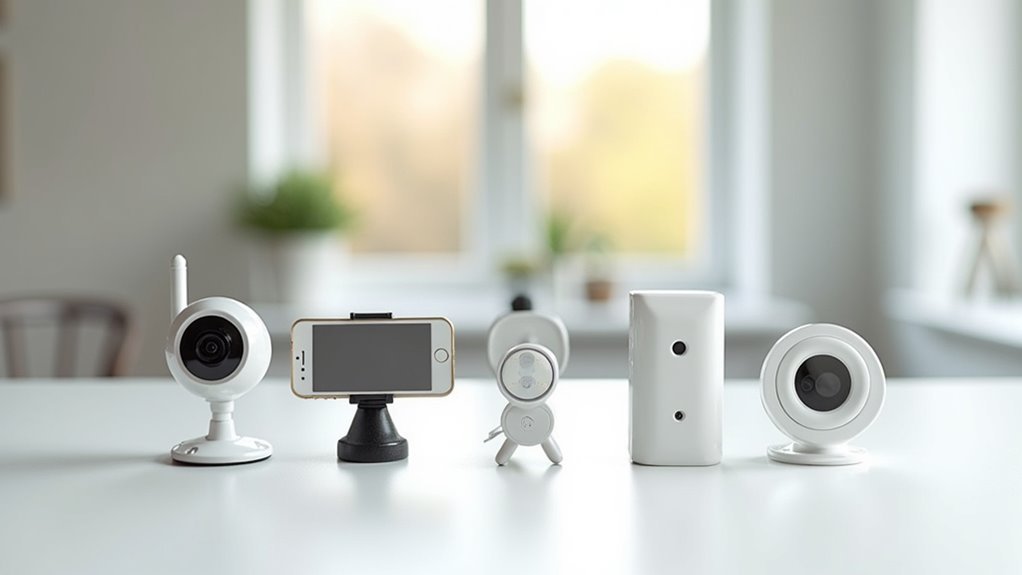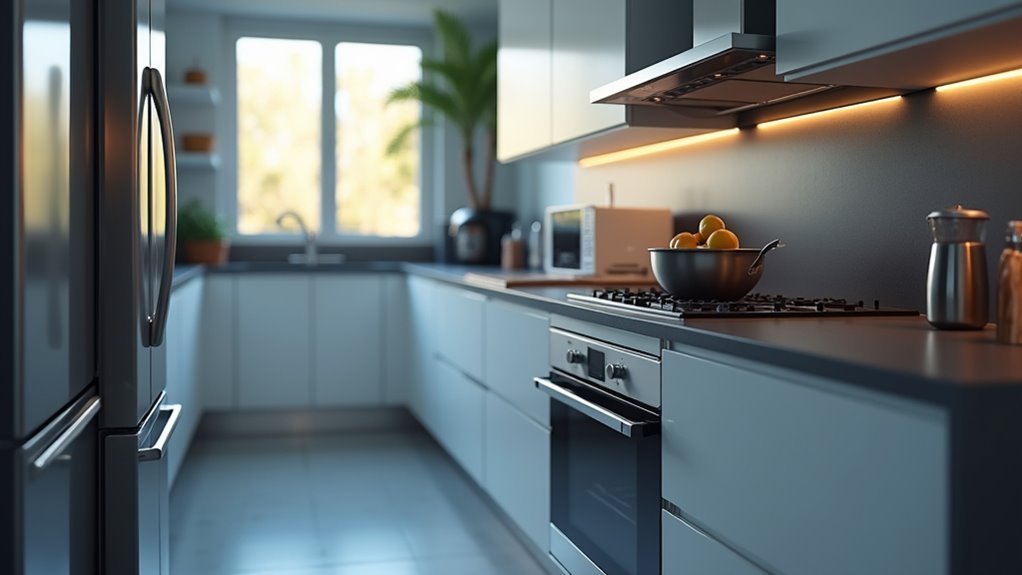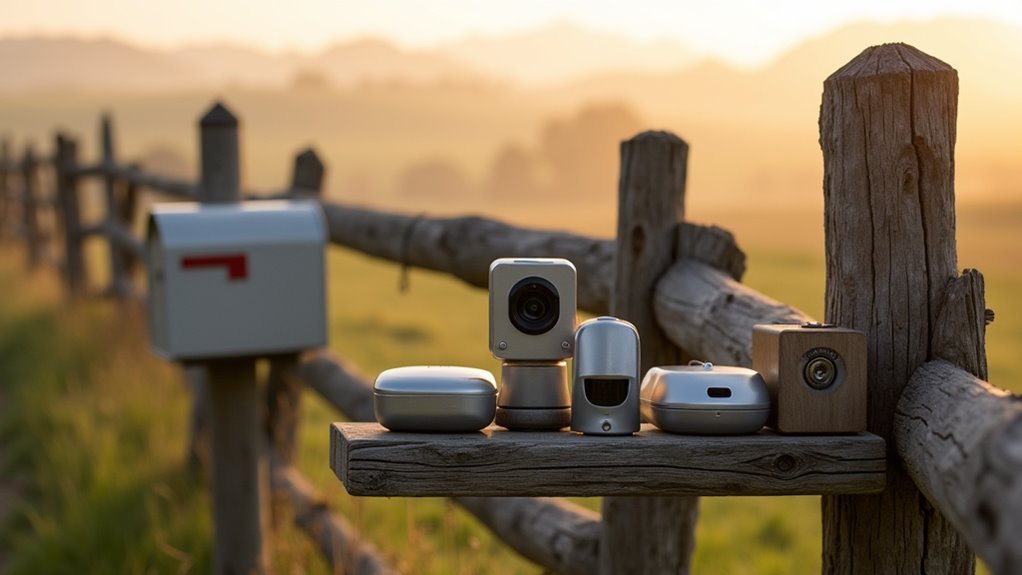You’ve probably wondered if there’s a way to keep an eye on your furry friend without spending hundreds on commercial pet cameras. The good news is that you can create your own professional-grade monitoring system using devices you likely already own. With the right setup, you’ll transform ordinary electronics into a thorough surveillance network that rivals expensive alternatives. However, there’s a vital first step that most pet owners overlook, and it could make or break your entire project.
Choose the Right Device for Your Pet Monitoring Setup

When setting up a video pet monitor, you’ll need to select a device with a built-in camera that can reliably stream footage to your remote location. iPads, laptops, and smartphones work excellently for this purpose since they’re equipped with quality cameras and internet connectivity.
You’ll want to ascertain your chosen device maintains stable internet connection for seamless video streaming and real-time notifications.
Position your device strategically to monitor your dog effectively. A custom stand provides stability while preventing potential damage from curious pets.
Consider devices that support motion detection features – these automatically alert you when your pet moves around, helping capture important behavioral moments.
Apps like Presence or Skype can transform your device into a professional-grade pet monitor, enabling two-way communication with your furry companion.
Download and Configure Pet Camera Applications
Several excellent pet camera applications can transform your existing device into a sophisticated monitoring system. Search for apps like Presence or iCAM in the App Store or Google Play Store, guaranteeing compatibility with your device. After downloading, create an account using your email and password to access configuration settings.
| Configuration Step | Action Required |
|---|---|
| Device Roles | Set iPad as Pet Cam, smartphone as viewer |
| Motion Detection | Adjust sensitivity for your pet’s activity |
| Notifications | Configure alert preferences |
| Audio Settings | Enable two-way communication |
| Testing | Verify live feed quality |
Designate device roles within the app settings—your tablet becomes the Pet Cam while your phone serves as the viewer. These applications effectively convert standard web cams into professional monitoring systems. Adjust motion detection sensitivity and test functionality to guarantee clear video and audio capture.
Position Your Camera for Optimal Pet Viewing

Proper camera placement determines the quality and usefulness of your pet monitoring footage. Position your camera to record at your pet’s eye level for natural perspectives that capture their activities authentically.
Choose locations with minimal obstructions like furniture to maximize your field of view and eliminate blind spots throughout the whole room.
Secure your camera using a stable mount or stand to prevent your pet from knocking it over during play. Place it near your pet’s favorite resting or activity areas to capture engaging daily behaviors.
Test various angles and distances to find the best setup that provides clear visibility while maintaining your pet’s comfort. This strategic positioning guarantees you’ll capture meaningful footage of your pet’s routine activities effectively.
Set Up Motion Detection and Alert Systems
You’ll want to configure your camera’s sensitivity settings to avoid constant alerts from your pet’s normal movements while still capturing important activity.
Enable email notifications so you’re immediately informed when your pet does something significant or concerning while you’re away.
Test your camera’s detection range by walking through different areas to make sure it properly monitors your pet’s favorite spots and movement patterns.
Configure Sensitivity Settings
Configuring your pet monitor’s sensitivity settings correctly makes the difference between receiving useful alerts and being overwhelmed by false notifications.
You’ll want to adjust these settings to capture your pet’s significant movements while filtering out minor disturbances like passing cars or shifting shadows. When motion is detected, your system should trigger meaningful alerts rather than constant interruptions.
Use your app’s testing feature to fine-tune detection accuracy. Configure sensitivity settings by starting with medium sensitivity, then adjust based on your pet’s activity patterns and environmental factors.
Remember to regularly review these settings as lighting conditions and room layouts change over time.
- Set up customizable monitoring zones focusing on your pet’s favorite areas
- Test different sensitivity levels during various times of day
- Adjust settings seasonally to account for changing light patterns
Enable Email Notifications
Since email notifications serve as your primary communication link with your pet monitor, setting them up correctly guarantees you’ll receive timely updates about your pet’s activities without missing critical moments.
Navigate to your pet monitoring app’s notification settings and enable email alerts for motion detection events. Input your preferred email address where you’ll receive instant notifications when your security camera detects movement.
Configure the alert frequency to prevent inbox overload while ensuring you don’t miss important activities. Test the system by triggering motion in your camera’s view and confirming you receive prompt email notifications.
Remember that reliable internet connectivity remains essential for seamless delivery of these alerts to your inbox.
Test Detection Range
Testing your pet monitor’s detection range requires systematic movement through different zones of the camera’s field of view to establish reliable monitoring boundaries.
You’ll need to walk through the camera’s frame at various distances to determine the maximum distance at which motion is detected reliably. This process helps you understand your system’s capabilities and limitations.
Testing thoroughly is a good idea because it prevents missed alerts when your pet moves beyond the effective range.
Mark the boundaries where detection becomes unreliable to optimize your camera’s positioning.
- Walk slowly at different distances from near to far zones
- Test detection range from multiple angles within the field of view
- Document locations where motion detection starts failing consistently
Test Video Quality and Audio Communication Features
You’ll need to thoroughly test your video pet monitor’s audio clarity and video resolution to guarantee reliable communication with your pet.
Start by conducting test calls at various times throughout the day, speaking clearly to evaluate any delays, distortions, or background noise that could interfere with your interactions.
Optimize your video resolution to at least 720p and adjust camera settings based on different lighting conditions to maintain consistent visual quality.
Audio Clarity Testing
Although ideal video quality captures your pet’s visual behavior, clear audio communication proves equally essential for effective interaction through your pet monitor.
You’ll need to test audio clarity systematically to ascertain peak communication effectiveness between you and your pet.
Start by positioning your microphone strategically in unobstructed areas where your pet typically spends time. Use a quiet environment during initial setup to establish baseline audio quality and adjust microphone settings to minimize background interference.
- Conduct test calls between your device and the monitor to evaluate both audio input and output clarity
- Check transmission latency during calls, as delays can hinder real-time communication
- Record sample audio clips through the monitoring app for review and quality adjustments
These steps guarantee reliable two-way communication when you’re away.
Video Resolution Optimization
Video resolution optimization forms the foundation of effective pet monitoring, requiring you to maximize your camera’s capabilities for crystal-clear visual tracking. Set your video resolution to the highest available option, typically 1080p, to capture detailed images of your pet’s activities and behaviors. This enhanced clarity helps you spot subtle movements and monitor your pet’s well-being accurately.
Your internet connection directly impacts video quality performance. Use a stable wired connection or high-speed Wi-Fi to prevent lag and buffering during live streaming. Poor connectivity causes pixelated footage and delayed transmission.
Conduct trial runs at various times throughout the day to assess how lighting conditions affect your video resolution optimization. Adjust camera settings accordingly and regularly update your monitoring software to maintain peak performance and access latest quality improvements.
Secure Your DIY Pet Monitor With Proper Passwords

Why risk exposing your furry friend’s private moments to strangers when a few security measures can keep prying eyes away?
To secure your DIY pet monitor effectively, you’ll need strong passwords as your first line of defense against unauthorized access.
Here are essential security steps to protect your pet monitoring system:
- Create complex passwords combining uppercase letters, numbers, and special characters for maximum protection
- Enable two-factor authentication on your camera app to add an extra security barrier against potential breaches
- Register your devices with manufacturers to receive critical security updates addressing newly discovered vulnerabilities
Change your passwords every few months to stay ahead of potential leaks.
Confirm your devices include encryption features to protect transmitted data.
These simple precautions keep your pet’s footage private and secure.
Troubleshoot Common Connectivity and Performance Issues
Three main culprits typically cause pet monitor frustration: weak Wi-Fi signals, outdated software, and insufficient internet speeds.
You’ll want to verify both your pet monitor device and viewing device connect to the same stable Wi-Fi network to minimize connectivity issues and enable smooth streaming.
Test your internet speed using online tools—you’ll need at least 1 Mbps upload speed for reliable video without interruptions.
If you’re experiencing lag or disconnection, move your camera or viewer closer to your router for stronger signals.
Don’t forget to update your monitoring app regularly, as updates include bug fixes and performance improvements.
When problems persist, restart both devices to reset connections.
Consider enabling auto answer features to maintain continuous monitoring without manual intervention.
Frequently Asked Questions
How Do You Make Cute Pet Videos?
You’ll capture adorable pet videos by using your smartphone’s auto-focus, practicing tricks beforehand, filming in natural daylight, filling the frame with your pet’s face and body, and experimenting with different cameras.
How Do You Film a Dog Video?
You’ll want to use your smartphone’s auto-focus feature while positioning yourself at your dog’s eye level. Fill the frame with their face and body, then zoom in during exciting moments for dynamic close-ups.
What Is the App That Makes Dogs Look at Cameras?
You’ll want the “Pet Camera” app, which uses sounds and treats to grab your dog’s attention. It’s available on both iOS and Android, featuring treat dispensers and two-way audio to encourage camera engagement.
What Is the Easiest Pet Camera to Set Up?
You’ll find the Presence app is the easiest pet camera to set up. Simply download it, log in, and configure your old iPad or smartphone’s role – it’s perfect for basic app users.





Leave a Reply